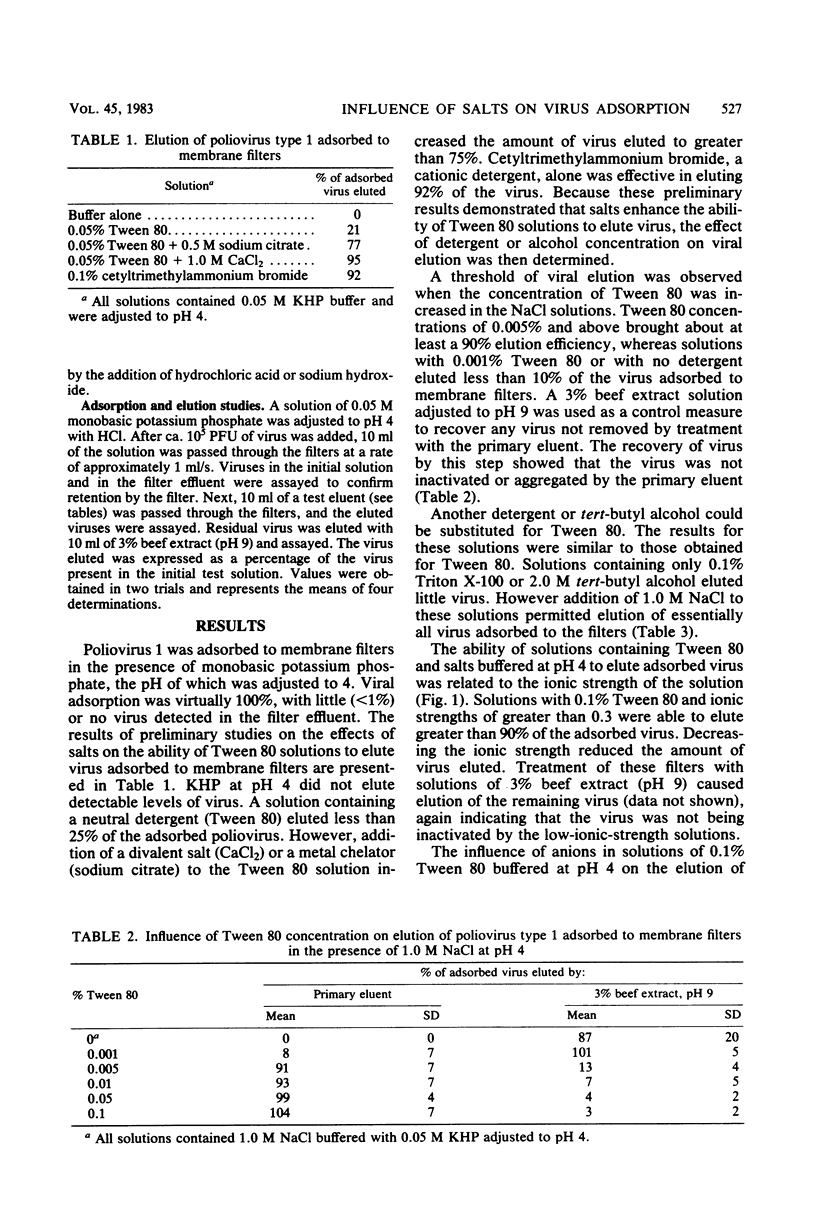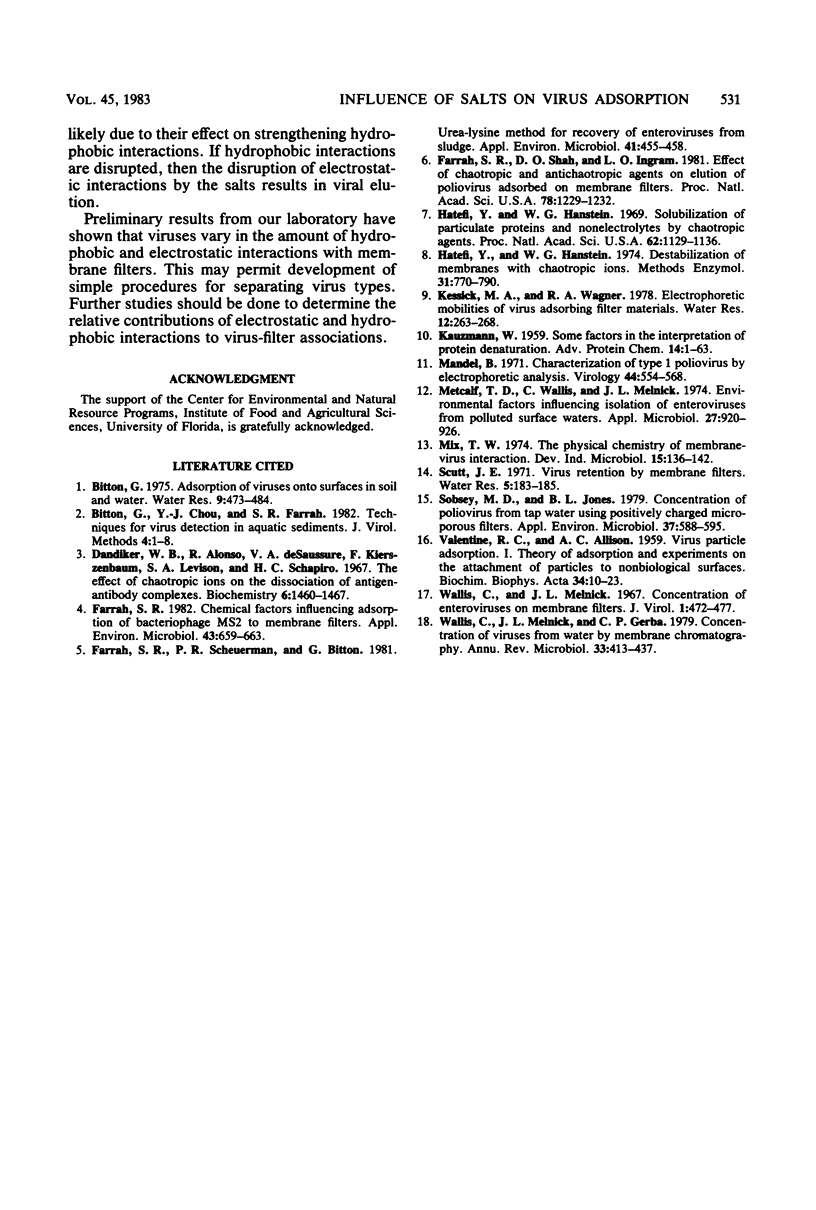Abstract
Neither solutions of salts nor solutions of detergents or of an alcohol at pH 4 are capable of eluting poliovirus adsorbed to membrane filters. However, solutions containing both a salt, such as magnesium chloride or sodium chloride, and a detergent or alcohol at pH 4 were capable of eluting adsorbed virus. The ability of ions to promote elution of virus at low pH in the presence of detergent or alcohol was dependent on the size of the ions and the ionic strength of the medium. These results suggest that both electrostatic and hydrophobic interactions are important in maintaining virus adsorption to membrane filters. Hydrophobic interactions can be disrupted by detergents or alcohols. It appears that electrostatic interactions can be disrupted by raising the pH of a solution or by adding certain salts. Disruption of either electrostatic or hydrophobic interactions alone does not permit efficient elution of the adsorbed virus at low pHs. However, when both interactions are disrupted, most of the poliovirus adsorbed to membrane filters is eluted, even at pH 4.
Full text
PDF





Selected References
These references are in PubMed. This may not be the complete list of references from this article.
- Bitton G., Chou Y. J., Farrah S. R. Techniques for virus detection in aquatic sediments. J Virol Methods. 1982 Feb;4(1):1–8. doi: 10.1016/0166-0934(82)90048-9. [DOI] [PubMed] [Google Scholar]
- Farrah S. R. Chemical factors influencing adsorption of bacteriophage MS2 to membrane filters. Appl Environ Microbiol. 1982 Mar;43(3):659–663. doi: 10.1128/aem.43.3.659-663.1982. [DOI] [PMC free article] [PubMed] [Google Scholar]
- Farrah S. R., Scheuerman P. R., Bitton G. Urea-lysine method for recovery of enteroviruses from sludge. Appl Environ Microbiol. 1981 Feb;41(2):455–458. doi: 10.1128/aem.41.2.455-458.1981. [DOI] [PMC free article] [PubMed] [Google Scholar]
- Farrah S. R., Shah D. O., Ingram L. O. Effects of chaotropic and antichaotropic agents on elution of poliovirus adsorbed on membrane filters. Proc Natl Acad Sci U S A. 1981 Feb;78(2):1229–1232. doi: 10.1073/pnas.78.2.1229. [DOI] [PMC free article] [PubMed] [Google Scholar]
- Hatefi Y., Hanstein W. G. Destabilization of membranes with chaotropic ions. Methods Enzymol. 1974;31:770–790. doi: 10.1016/0076-6879(74)31080-4. [DOI] [PubMed] [Google Scholar]
- KAUZMANN W. Some factors in the interpretation of protein denaturation. Adv Protein Chem. 1959;14:1–63. doi: 10.1016/s0065-3233(08)60608-7. [DOI] [PubMed] [Google Scholar]
- Mandel B. Characterization of type 1 poliovirus by electrophoretic analysis. Virology. 1971 Jun;44(3):554–568. doi: 10.1016/0042-6822(71)90369-2. [DOI] [PubMed] [Google Scholar]
- Metcalf T. G., Wallis C., Melnick J. L. Environmental factors influencing isolation of enteroviruses from polluted surface waters. Appl Microbiol. 1974 May;27(5):920–926. doi: 10.1128/am.27.5.920-926.1974. [DOI] [PMC free article] [PubMed] [Google Scholar]
- Sobsey M. D., Jones B. L. Concentration of poliovirus from tap water using positively charged microporous filters. Appl Environ Microbiol. 1979 Mar;37(3):588–595. doi: 10.1128/aem.37.3.588-595.1979. [DOI] [PMC free article] [PubMed] [Google Scholar]
- VALENTINE R. C., ALLISON A. C. Virus particle adsorption. I. Theory of adsorption and experiments on the attachment of particles to non-biological surfaces. Biochim Biophys Acta. 1959 Jul;34:10–23. doi: 10.1016/0006-3002(59)90228-8. [DOI] [PubMed] [Google Scholar]
- Wallis C., Melnick J. L. Concentration of enteroviruses on membrane filters. J Virol. 1967 Jun;1(3):472–477. doi: 10.1128/jvi.1.3.472-477.1967. [DOI] [PMC free article] [PubMed] [Google Scholar]
- Wallis C., Melnick J. L., Gerba C. P. Concentration of viruses from water by membrane chromatography. Annu Rev Microbiol. 1979;33:413–437. doi: 10.1146/annurev.mi.33.100179.002213. [DOI] [PubMed] [Google Scholar]


